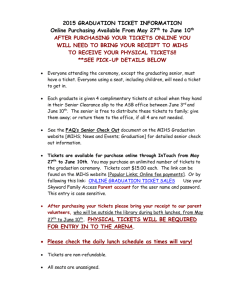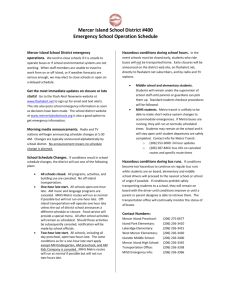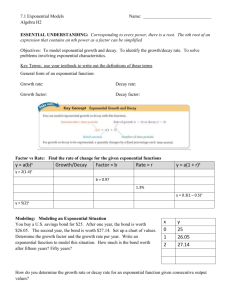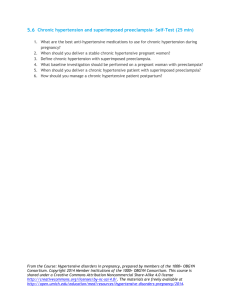ppt
advertisement
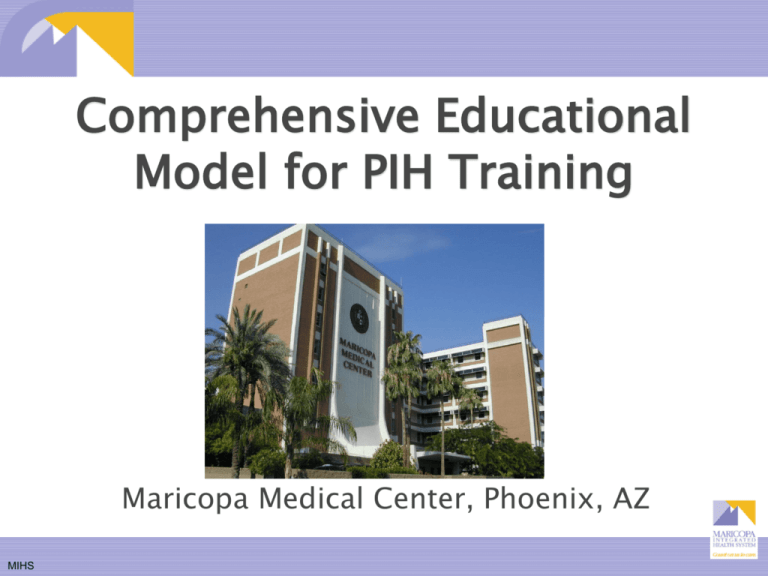
Comprehensive Educational Model for PIH Training Maricopa Medical Center, Phoenix, AZ 1 MIHS Objectives • Provide an educational model for PIH training, incorporating effective simulation for participants to integrate into your organizational practice • Share CMQCC initiatives & toolkit • Identify predictors of PIH through nursing assessment and incorporate appropriate interventions • Recognize the value of simulation and debriefing components to overall improved patient outcomes 2 MIHS U.S. Maternal Mortality • CDC Review of 14 years of coded data 1979-1992 • 4024 maternal deaths • 790 (19.6%) from preeclampsia 77.4% 3 MIHS Obstetrics and Gynecology 2001;97:533 Maternal Hypertension in 1999-2005 All maternal hypertension identified at time of hospitalization for labor and delivery (includes pre-gestational and gestational hypertension) Source: http://www.cdph.ca.gov/programs/mcah/Documents/MO-CAPAMRTrendsinMaternalMorbidityinCalifornia-1999-2005-TechnicalReport.pdf 4 MIHS Maternal Morbidity Based on Mortality Approx. 8 Preeclampsia Related Mortalities / Year in CA Near Misses: 80 1x 10x 100x 5 MIHS Serious Morbidity: 800 • Goal: Eliminate preventable maternal death & injury & promoting equitable maternal care 6 MIHS • • • • Resources Tools Measures Quality improvement techniques What are the goals for Preeclampsia Collaborative? – Early recognition of elevated BPs (re-check, notify physician) – Early and aggressive treatment (anti-hypertensives) – Staff education – Patient education and timely follow-Up – Patient Outcomes: Showing reduced rate of morbidities, complications & extended LOS, improved patient education 7 MIHS If Only We Knew -The Quest to Conquer Preeclampsia If Only We Knew (video) 8 MIHS Preeclampsia Collaborative Participants Northern CA • • • • • • • • • • • • • Alta Bates Summit Contra Costa Regional Med Ctr Doctor’s Hospital of Modesto John Muir Medical Center Kaiser Hayward Kaiser Oakland Kaiser Roseville Kaiser Santa Clara Mercy San Juan Med Center NorthBay Medical Center Salinas Valley Memorial Sonora Regional Med Center Sutter Medical Center Southern CA • • • • • • • • • • • • Arrowhead Regional Med Ctr Cedars Sinai Med Center Citrus Valley Med Center Henry Mayo Newhall Memorial Kaiser San Diego Kaiser West LA Long Beach Miller Riverside County Regional Med Ctr St. Jude Medical Center Saddleback Memorial UCLA St Bernardine Medical Center • MIHS~Phoenix,AZ 9 California & ONE Arizona hospital representing ~ 82,000 births in 2011 (1:6 25 MIHS Why is MIHS participating in the Collaborative? • The primary aim of the Preeclampsia Collaborative is to help reduce the rate of severe morbidities in women with any hypertension &/or severe preeclampsia/eclampsia & to reduce a significant portion of complications & extended hospital stays with the use of tools & guidelines developed to support early recognition, diagnosis, treatment & management of preeclampsia & triggers requiring immediate evaluation. 10 MIHS MIHS Exceeds Target Rates • California has a target of 8.8% for severe morbidity (complications) with hypertension. • MMC/MIHS has consistently performed better than the target rate 11 MIHS Severe Morbidity with Preeclampsia: Jul 2012-Jan 2013 12 MIHS Timeline Jan 2013 Feb 2013 Mar 2013 Apr 2013 May 2013 July 2013 13 MIHS • Comprehensive model for treatment developed @ MMC • CMQCC Pre-eclampsia Task Force (first meeting) • MMC OB Skills Fair • Revised Pre-eclampsia debrief form • Pocket medication cards made/distributed • ASCOM Phones implemented for emergencies Timeline, continued Sept 2013 Oct 2013 Jan 2014 Feb 2014 Mar 2014 Future 14 MIHS • MMC presented successes at CMQCC Mtg in CA • Pregnancy Induced Hypertension Training • CMQCC Tool Kit available on website: FREE! • CMQCC wins ACOG award for Tool Kit • MMC OB Alert Drills with simulation • Ongoing unannounced drills, training NICE Guidelines • Recommendation 7: Systolic hypertension requires treatment – 7.1 All pregnant women with pre-eclampsia and a systolic blood pressure of 150-160 mmHg or more require urgent and effective anti-hypertensive treatment in line with the recent guidelines from the National Institute for Health & Clinical Excellence (NICE)3. Consideration should also be given to initiating treatment at lower pressures if the overall clinical picture suggests rapid deterioration and/or where the development of severe hypertension can be anticipated. The target systolic BP after treatment is 150 mmHg. From CMACE 2011 report of maternal deaths from 2006-2008 15 MIHS BP Treatment Systolic ≥ 160 Diastolic ≥ 105 Treatment within 15-30 min Gestational HTN = Preeclampsia = Severe Preeclampsia = ECLAMPSIA 16 MIHS Key Points • Detect elevated BP in perinatal period • Take BP in a seated or semi-fowler’s position • If elevated (>=160 systolic OR >=105 diastolic), repeat in 10 minutes • If remains elevated, notify physician within 5 minutes 17 MIHS Key Points continued • Antihypertensive meds administered within 30 minutes • Patients that are discharged having had elevated BP, follow up reevaluation w/n 7 days • Discharge teaching instructions provided regarding signs & symptoms of preeclampsia 18 MIHS Comprehensive Educational Model Developed • Nursing Leadership Team – Clinical Educators – Nurse Managers – Clinical Resource Leaders 19 MIHS PIH Training Model Platform • • • • • • • • 20 MIHS 10 offerings of class (3 hour each) Pre-test Didactic lecture Demo/return demo: physical assessment & pump set-up 4 Standardized patient simulation scenarios Post-debriefing with all scenarios Post-test Evaluation Class Training Objectives • Identify expected clinical findings during health assessment of patient presenting with PIH • Recognize symptoms associated with Magnesium toxicity • Assess various patient scenarios in real time simulation, by evaluating and implementing appropriate nursing interventions • Demonstrate use of SBAR Communication with team members 21 21 MIHS Didactic Lecture Content • • • • • • • 22 MIHS Normal Physiology, S/S Pre-eclampsia Lab Testing / Values Intrapartum & Postpartum Management Pharmacologic Interventions Eclampsia, HELLP CMQCC Practice Changes Practice Changes • Magnesium Sulfate 23 MIHS • Labeling Tubing Standardized Patients & Confederates 24 MIHS Standardized Patients & Confederates • • • • • 25 MIHS Suspend disbelief > promotes realism Proper training > enhances emotional fidelity Guide scenario-specific tasks > meet objectives Bring to life the lesson intent > believability Experiential learning > risk free environment Show Time! 26 MIHS Pregnancy Induced Hypertension 27 MIHS Props and Costumes • • • • • Bridge the gap Cue cards Helping cues adapted to match learner’s path Assigned actual learners roles Minimize uncertainty: Orient learner to learning environment, props, characters, boundaries and maximize real-time 28 MIHS 29 MIHS Eclampsia 30 MIHS Simulation is the Perfect Stage! • • • • • • 31 MIHS Real-time learning Experiential, safe, supportive environment Practice, observation Commit errors without risk to patients Feedback, reflection Interpret and integrate knowledge, skills & attitudes 32 MIHS Magnesium Sulfate Toxicity 33 MIHS Scenes and Scripts • Based on specific learning objectives of the simulation sessions • Improvising is essential • Connection between all participants • Flexibility for rapidly changing circumstances • Teamwork is key! 34 MIHS Course Evaluations • 52 nurses participated • 51 of 52 passed post-test with scores of 90% or greater • Summary evaluations = 4.9/5.0 35 MIHS Severe Morbidity (excluding Hemorrhage) with Preeclampsia: Feb 2013-Jan 2014 36 MIHS Timely Treatment of Severe Hypertension Jul 2012-Jan 2013 37 MIHS Timely Treatment of Severe Hypertension within 60 Minutes Follow Up 2/13-1/14 38 MIHS Preeclampsia Collaborative Maricopa Medical Center 2014 and Future • Working on implementing new ACOG recommendations • Providers developing protocol to ensure patients are seen for BP check within 3 days postpartum • Low-dose aspirin with history preeclampsia • Plan to present case studies to ED providers to stress importance of timely treatment and consultation for preeclamptic patients 39 MIHS Current Simulation Drills with Standardized Patient • OB Alert Training (online learning) • Ongoing OB Alert Drills (un-announced) – Emergency Department (more) – On Postpartum Unit (May 2014) – Cafeteria (June 2014) 40 MIHS OB ALERT DRILL: ED 41 MIHS Debriefing Points 42 MIHS Debriefing Points, continued • What went well 43 MIHS Debriefing Points, continued • Teachable Moments… 44 MIHS Debriefing Points, continued • Room For Improvement! – Management of OB patient in ED – Familiarization with equipment – Assign learning module to Physicians, including Anesthesiologist and CRNAs – System issues - correct overhead paging – More un-announced drills!!! 45 MIHS Preeclampsia Toolkit Wins ACOG Award • https://www.cmqcc.org/preeclampsia_toolkit 46 MIHS Share This Link! 47 MIHS CMQCC Tool Kit • • • • • • • • • • 48 MIHS Executive Summary Clinical Pearls Patient and Treatment Recommendations Compendium of Best Practices Algorithms Appendices Simulations/Drills Slide set for Professional Education Patient Education Materials Multiple References Sample from the kit 49 MIHS Final Act! 50 MIHS Differential Diagnosis with History of Methamphetamine Use 51 MIHS Remember… 52 MIHS This is why we do the work that we do! Thank you! susan.pinto@mihs.org 53 MIHS References • • • • • • • American College of Obstetricians and Gynecologists’ Report (2013) Task force on hypertension in pregnancy, Vol 122, No. 5 Baile, W., Blatner, A. (2014) Teaching communication skills using action methods to enhance role-play in problem-based learning. Soiciety for Simulation in Healthcare, Vol.00, No.00 Fanning, R., Gaba, D., (2007) The role of debriefing in simulation-based learning. Society for Simulation in Healthcare, Vol.2, No.2 Gilbert, E.S. (2007). Manual of high-risk pregnancy and delivery. Fourth Ed. Mosby: Missouri. http://www.cdph.ca.gov/programs/mcah/Documents/MO-CAPAMRTrendsinMaternalMorbidityinCalifornia-1999-2005-TechnicalReport.pdf CMQCC http://www.cmqcc.org/preeclampsia_toolkit Improving health care response to preeclampsia: a california quality improvement toolkit CMQCC Mandeville, L.K. & Troiano, N.H. (1999). AWHONN High-Risk and Critical Care Intrapartum Nursing, 2nd Edition. Lippincott: Philadelphia. 54 54 MIHS References, continued • • • • 55 MIHS Mattson, S. & Smith, J. (2004) Core curriculum for maternal-newborn nursing, third edition, Elsevier Saunders, St. Louis MO. Preeclampsia Foundation http://www.preeclampsia.org/thenews/videos/video/if-we-only-knew-the-quest-to-conquer-preeclampsia Sanko, J., Shekhter, I., et. al. (2013) Establishing a convention for acting in healthcare simulation merging art and science. Society for Simulation in Healthcare, Vol.8, No.4 Shield, L. (2013) California maternal quality care collaborative and preeclampsia expert panel

